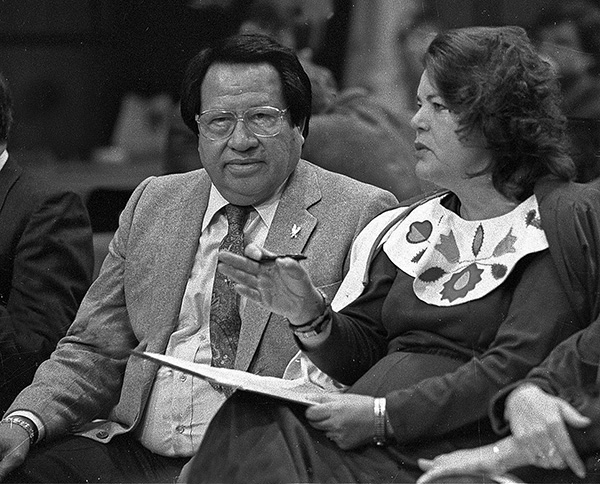44: “Return the Power of Governing” (1994)37
Wilma Mankiller
During the 1970s, Congress responded to demands for more power at the local level with incremental reforms, such as the Indian Self-Determination and Education Assistance Act (1975). Though a welcome departure from the near absolute control of the Bureau of Indian Affairs, critics argued that its emphasis on self-administration did not go far enough. Washington continued to hold the purse strings. By 1990, in response to the Reagan administration’s empowering government-to-government rhetoric but debilitating budget slashing actions, Congress enacted legislation that enabled select tribes to enter into compacts with the federal government. These compacts, expanded and made permanent in 1994, provided for tribal control over the administration and management of Indian Bureau programs, functions, and services and the authority to redesign them to fit tribal needs. Wilma Mankiller (1945–2010), the first woman to serve as principal chief of the Cherokee Nation of Oklahoma, supported self-governance and, in the following excerpts from three testimonies, explained why. Consider how her views of the federal government and the Bureau of Indian Affairs compare to those of Arthur Parker, Carlos Montezuma, D’Arcy McNickle, and Bruce Wilkie in previous chapters.38
I am convinced by my own work for the last twenty-five years in Indian communities that the best solution to problems in native communities come from within our own communities and our own tribes. . . . I believe very strongly that the BIA is an anachronism. It has barely changed since its inception, yet tribal governments have changed and the capacity of tribes to do things for themselves has changed dramatically. We have a lot of new initiatives that support tribal communities in the revitalization of tribal government and tribal communities, but the present BIA structure and attitude does not support tribal government and tribal revitalization. . . .

Cherokee principal chief Wilma Mankiller and Mississippi Band of Choctaw Indians chief Phillip Martin (Document 23) appear before the Senate Affairs Special Investigations subcommittee hearing in Washington, D.C., on 30 January 1989. AP Photo/Marcy Nighswander.
The Cherokee Nation has a history of treaty-making that began in 1785, and we view this self-governance compact basically as our newest treaty with the United States. It’s a very important initiative for us. . . . The self-governance project offers a real opportunity for the federal government to let go without diminishing or abrogating its trust and inter-governmental relations with the Cherokee Nation. . . . This has led the Nation in many endeavors to contract health care, to sponsor self-help community projects, and engage in the promotion of industries for tribal and private sector purposes throughout the northeastern Oklahoma area. . . . It is believed the single most important accomplishment is the assumption of direct administration of federal responsibilities overall. This reflects at least a mature relationship between the two sovereignties involved, the Cherokee Nation and the United States of America. . . . For the Cherokee Nation, the Self-Governance Project is the realization of an ideal to return the power of governing back to the Cherokees. . . .
We are very concerned that the U.S. government will see this as just another demonstration project and will not make this legislation permanent. . . . [The Self-Governance Act] has allowed us to allocate the resources where they are most needed, and respond to local needs, and it has been successful from our standpoint. . . . I also believe that the self-governance project or demonstration project, as it is now known, should include both the Bureau of Indian Affairs and the Indian Health Service. This piecemeal way of dealing with self-governance just through the BIA is not going to work. I think it has to be kind of across-the-board. . . . Always there are these great speeches about supporting tribal governments and that sort of thing in Washington from the leadership, but it needs to permeate every layer of these agencies, people we deal with on a day-to-day basis. . . .
HEALTH CARE IS not the only issue we are concerned about. The BIA funds for operating Indian schools are terribly insufficient. . . . The status of Indian tribes as sovereign governments, especially Self-Governance tribes, places a heavy responsibility on both the tribes and the federal government to assure that health programs for Indians are responsive to needs and lead to improvement of the overall health of persons served by the Indian health care system. . . . Because the purpose of the Self-Governance program is to enhance the inherent sovereignty of tribal governments and strengthen the government-to-government relationship between the United States and Indian tribal governments . . . the Subcommittee should ensure that the tribes themselves are consulted and participate in the planning and implementation of agency restructuring. There is real danger that the agencies will give only lip service to tribal participation.
